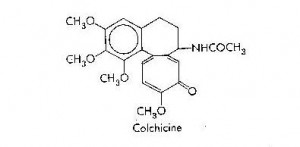Testimonials
REVIEWS OF DR. SCHULER
Dr. Schuler, explains Colchicine as treatment for Gout
This is the first in a series of articles I will write about the drugs for treating gout.
Colichicine is the first drug used in the treatment of a acute gouty attack Gout is a metabolic condition caused by an elevation in uric acid in the bloodstream. This increase can lead to a abnormal deposit of painful urate crystals in and around joints, and in soft tissue structures, Gout is the most common form of crystalline arthritis.
A gouty attack is incredible painful. It is not just painful but among the most painful conditions you can get. It occurs most commonly in the big toe joint with the foot becoming red hot and swollen, with limitation of motion. The classic time for an attack of gout is early morning or late night. The underlying cause for this is due to reabsorption of excess joint fluid at night, that results in the increase deposit of the very painful uric acid crystals into the joint. You see if there is more fluid in the joint the urate crystal are in a liquid state and are less likely to become painful because as a liquid they are floating around in the joint and not cutting into the joint . Most patients are men between the ages of 30-60, most commonly around 50.
History. Colchicine is from the plant Colchicum autumnale that is found in the Colchis area of Asia. Colchicine was introduced for the therapy of acute gout by Anton von Storck in 1763,. Benjamin Franklin, had gout, and was reputed to have introduced colchicine as a therapy in the United States. Colchicine is a one of a kind anti-inflammatory drug, It’s single real use is for the treatment and prevention of gout and gouty arthritis Historically gout was divided into primary and secondary phases.. Colchicine is used in the first phase which is the acute, crushing pain when gout first hits. It gives dramatic relief from this crushing pain Four drugs of proven value are available and commonly used during the first phase, : colchicine, phenylbutazone, indomethacin, and corticosteroids (or ACTH). The second phase of the treatment of gout is the long term management to prevent gouty attacks from coming back which I will write about in the future.
The aim of Colchicine therapy is to reduce the severity of the gouty pain and quickly terminate the acute inflammatory process associated with it. The patient should also rest as much as possible during this attack and immobilized and protected the effected area.
Colchicine is also unique in that if the diagnosis is in doubt, a clear-cut response to colchicine is still widely used as confirmatory evidence of gout.
The response to this drug is often dramatic. Joint pains and swelling begin to subside approximately twelve hours after the institution of therapy and in most instances pain is completely relieved in from one to two days. Over 95 per cent of acute attacks are materially benefited by a single course of colchicine. The response to colchicine is often disappointing if the drug is started several days after the onset of acute symptoms; relief is usually prompt if therapy is begun at the very onset of the attack. Should no benefit occur, a second course can be given after an interval of three days; repetition sooner might precipitate marked gastrointestinal symptoms.
SIDE EFFECTS: There are many side effects The most common side effects of colchicine are nausea, vomiting, abdominal pain, diarrhea difficulty breathing; swelling of your face, lips, tongue, or throat.. Colchicine also may cause hair loss, weakness, and nerve irritation. All patients taking colchicine long-term require monitoring of their blood counts because it can cause damage to their bone marrow causing severe anemia, low white blood counts, and low platelets. Reduced white blood cell counts may increase the risk of infections. Colchicine also may cause muscle pain (myopathy) or severe muscle breakdown (rhabdomyolysis). Patients with renal or liver dysfunction or taking some other drugs (for example, simvastatin and other statins, gemfibrozil, fenofibrate), which also affect muscle tissue, are at a higher risk of developing rhabdomyolysis.
Grapefruit and grapefruit juice may interact with colchicine and lead to potentially dangerous effects; be sure to ask your doctor about this.
DRUG INTERACTION: Colchicine can interact with many drugs. . Tell your doctor about all other medications you use, especially: cholesterol-lowering medicines such as atorvastatin (Lipitor), fenofibrate (Antara, Lipofen, TriCor), digoxin (Lanoxin, digitalis);gemfibrozil (Lopid), simvastatin (Zocor), lovastatin (Mevacor), pravastatin (Pravachol), and antibotices such as erythromycin
For more information about gout here is a video by Dr. Burton S. Schuler
Dr. Burton S. Schuler is a foot doctor, foot specialist (Podiatrist), of Panama City, Fl and the director of the Ambulatory Foot Clinics Podiatric Pain Management Center. He is also the author of the new book Why You Really Hurt: It All Starts In The Foot


